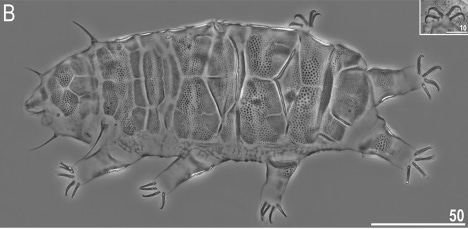Echiniscus attenboroughi, Echiniscus dentatus, and Pseudechiniscus linnaei are three of nineteen newly described species of tardigrades from South Africa. They were discovered in the course of a study that collected samples from three South African provinces: the Western Cape, Eastern Cape and KwaZulu-Natal, collecting 550 samples from 42 localities.
Echiniscus attenboroughi, lateral, scale = µ. From Gasiorek et al., 2022.
The methods used to collect these tiny animals hint at their remarkable physiology. Samples of mosses and lichens were gathered and air dried. Later, in the lab, they were rehydrated and a soup of sediments visually searched under a microscope for living tardigrades. Specimens recovered were subsequently examined using light microscopy, scanning electron microscopy and DNA sequencing. More on the significance of tolerating desiccation in a moment.
If you are not familiar with tardigrades, you may be asking what, exactly, these little animals are. First described in 1773, they are a phylum unto themselves, the Tardigrada, that are most closely related to arthropods and onychophorans, the velvet worms. Arthropods are the massive lineage including crabs, spiders, millipedes, insects, and relatives. Like arthropods, they grow by ecdysis, moulting their cuticle between spurts of growth. These animals occur worldwide, from pole to pole, and are so far known from about 1,300 species although many more remain to be discovered.
The South African survey focused on water bears found in mosses and lichens, but they are also found in soil, leaf litter, coastal sand dunes, and both freshwater and marine sediments where there may be as many as 95,000 water bears per gallon. They have been collected from high mountaintops to deep sea trenches; from hot springs to under ice. The first one I ever saw was from a decidedly less exotic habitat: rotting leaves in the gutter of a house. Their diets consist of algae, plant material (depending on the substrate), and tiny invertebrates, including other water bears.
Molecular studies show that they lack the genes that code for the thoracic and abdominal segmentation of insects, so it appears that, with the exception of the posterior pair of legs, their body consists of segments corresponding to those fused long ago into the head capsule of insects.
Water bears are famous, in circles that get excited by such things, for their ability to suspend their metabolism and go into a resting stage in response to hostile circumstances, then become restored and resume their lives when conditions are again favorable. Hence the dried samples employed while collecting them. In this resting condition their metabolism slows to 1/100th of its normal rate. They have been documented to survive without food or free water for decades, then, when rehydrated, resume their normal activities. Even when in completely dry conditions, they can survive up to ten years. I think this reanimation is such an impressive physiological feat that animals achieving it deserve to be recognized. Perhaps we could call them retardigrades.
Psudechiniscus linnaei, dorso-lateral (insert of claws II) scale = µ. From Gasioreck et al., 2022.
There should be a whole chapter in the Guinness book of world records devoted to moss piglets. Among their extreme tolerances are survival at temperatures as high as 304 degrees F.; a few days at negative 328 degrees F.; a few minutes at negative 458 degrees F; pressure of 6000 atmospheres, about six times greater than the pressure in the deepest ocean trench; over 19,600 feet elevation and depths of 15,000 feet beneath the surface. They have survived exposure to a thousand times more radiation than other animals can tolerate. Water bears were the first animal life shown to survive outer space when, in 2007, they were exposed to the hard vacuum of space while in earth orbit. Although many died, 68 percent were reanimated. Those exposed to UV in space, however, had a very low survival rate. Given all this, it has been speculated that they might be able to survive on Mars, if only there were something for them to eat.
Water bears even show up occasionally in pop culture, from comic books to song lyrics, horror films, and the video game Sam & Max: This time It’s virtual, that features an abandoned tardigrade amusement park called Cap’n Aquabear’s Funtime Park. But my favorite was the “moss piglets” episode of South Park in which an experiment has tardigrades learning to dance to Taylor Swift tunes. Better them than me.
Acknowledgment
I thank Dr. Piotr Gasiorek for his kind permission to reproduce images from his impressive monograph of South African tardigrades.
Reference
Gasiorek, P., Voncina, K., Bochnak, M., Surmacz, B., Morek, W., and L. Michalczyk (2022) Echiniscidae (Heterotardigrada) of South Africa. Zootaxa 5156: 1-238.







